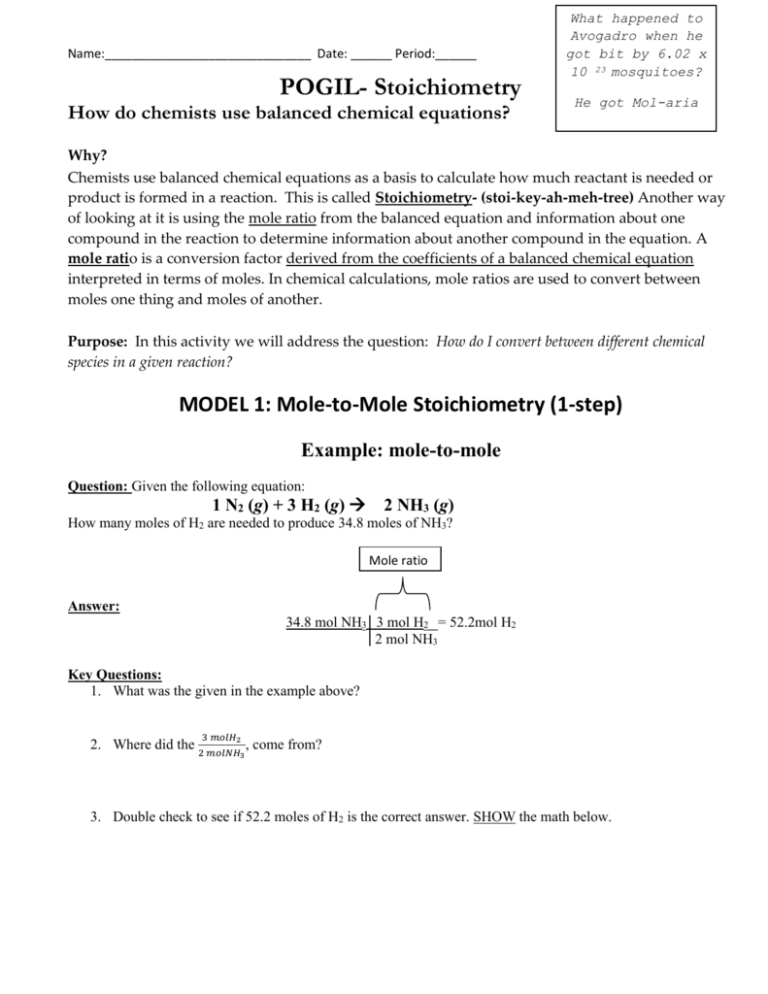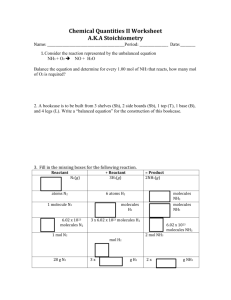1 N 2 (g) + 3 H 2
advertisement

Name:______________________________ Date: ______ Period:______ POGIL- Stoichiometry How do chemists use balanced chemical equations? What happened to Avogadro when he got bit by 6.02 x 10 23 mosquitoes? He got Mol-aria Why? Chemists use balanced chemical equations as a basis to calculate how much reactant is needed or product is formed in a reaction. This is called Stoichiometry- (stoi-key-ah-meh-tree) Another way of looking at it is using the mole ratio from the balanced equation and information about one compound in the reaction to determine information about another compound in the equation. A mole ratio is a conversion factor derived from the coefficients of a balanced chemical equation interpreted in terms of moles. In chemical calculations, mole ratios are used to convert between moles one thing and moles of another. Purpose: In this activity we will address the question: How do I convert between different chemical species in a given reaction? MODEL 1: Mole-to-Mole Stoichiometry (1-step) Example: mole-to-mole Question: Given the following equation: 1 N2 (g) + 3 H2 (g) 2 NH3 (g) How many moles of H2 are needed to produce 34.8 moles of NH3? Mole ratio Answer: 34.8 mol NH3 3 mol H2__= 52.2mol H2 2 mol NH3 Key Questions: 1. What was the given in the example above? 3 𝑚𝑜𝑙𝐻 2. Where did the 2 𝑚𝑜𝑙𝑁𝐻2 , come from? 3 3. Double check to see if 52.2 moles of H2 is the correct answer. SHOW the math below. Name:______________________________ Date: ______ Period:______ You Try… 4. Given the following chemical equation 4P + 5O2 2 P2O5 (a) How many moles of P2O5 are formed from 3.4 moles of O2? SHOW the math below (b) How many moles of P are needed to react with 30.1 moles of O2? SHOW the math below. 5. Aluminum reacts with copper(II) chloride to make aluminum chloride and copper (a) Write the balanced equation (b) Given 6 moles of CuCl2, how many moles of AlCl3 were made? SHOW the math below (c) If 4.5 moles of AlCl3 were made, how many moles of CuCl2 were used? SHOW the math below 6. Methane (CH4) and sulfur (S8) react to produce carbon disulfide and hydrogen sulfide, a liquid often used in the production of cellophane (a) Write the balanced equation (b) Calculate the moles of CS2 produced when 1.50 mol of S8 are used. SHOW the math below (c) How many moles of H2S are produced? SHOW the math below 7. Summarize model 1 in 2-3 sentences: Name:______________________________ Date: ______ Period:______ MODEL 2: Mole⟷Mass Stoichiometry (2-step) Example: Starting with the mole Question: Given the following equation: Molar Mass H2 1 N2 (g) + 3 H2 (g) 2 NH3 (g) How many grams of H2 are needed to produce 34.8 moles of NH3? Mole ratio (2 x 1.0 g/mol) = 2.0 g/mol Molar Mass Answer: 34.8 mol NH3 3 mol H2 2 mol NH3 2.0 g H2 = 104.4 g H2 1 mol H2 Key Questions: 8. What was the given in the example above? 9. Where did the 3 𝑚𝑜𝑙𝐻2 2 𝑚𝑜𝑙𝑁𝐻3 , come from? 2.0 𝑔𝐻 10. Where did the, 1 𝑚𝑜𝑙𝐻2 come from? 2 11. Look at the periodic table, how much does one mole of a Hydrogen atom weigh? Why is the molar mass of hydrogen (H2) 2.0 g/mol in the example 1 above? 12. Double check to see if 104.4 g H2 is the correct answer. SHOW the math below. You Try… 13. Given the following chemical equation 4 P + 5O2 2 P2O5 (a) What is the molar mass of P2O5? (use your periodic table). SHOW the math below (b) How many grams of P2O5 are formed from 3.4 moles of O2? SHOW the math below Name:______________________________ Date: ______ Period:______ 14. Acetylene gas (C2H2) and calcium hydroxide are produced by adding water to calcium carbide(CaC2) (a) Write the balanced equation (b) What is the molar mass of acetylene, C2H2? show your math below. (c) How many grams of acetylene, C2H2, are produced by adding 3 moles of CaC2? show your math below. (d) What is the molar mass of CaC2? show your math below. (e) How many grams of CaC2 are needed to react completely with 490.0 moles H2O? show your math below. Example: starting with the mass Question: Given the following equation: 1 N2 (g) + 3 H2 (g) 2 NH3 (g) How many moles of H2 are needed to produce 34.8 grams of NH3? Molar Mass Molar Mass NH3 14 g/mol + (3 x 1.0 g/mol) = 17 g/mol Mole ratio Answer: 34.8 g NH3 1 mol NH3 17.0 g NH3 3 mol H2 = 3.07 mol H2 2 mol NH3 Key Questions: 15. What was the given in the example above? 16. Look at the periodic table, how much does Hydrogen weigh? Nitrogen weigh? 1 𝑚𝑜𝑙𝑁𝐻 17. Where did the 17 𝑔 𝑁𝐻 3 , come from? 3 18. Where did the, 3 𝑚𝑜𝑙𝐻2 2 𝑚𝑜𝑙 𝑁𝐻3 come from? 19. Double check to see if 3.07 mol H2 is the correct answer. SHOW the math below. Name:______________________________ Date: ______ Period:______ You Try… 20. Given the following chemical equation 4 P + 5O2 2 P2O5 (a) What is the molar mass of O2? show your math below. (b) How many moles of P2O5 are formed from 3.4 grams of O2? SHOW the math below 21. Titanium is a transition metal used in many alloys because it is extremely strong and light weight. Titanium tetrachloride is extracted from titanium(IV) oxide, using chlorine and coke (carbon). Carbon dioxide is also released. (a) Write the balanced equation (b) Calculate the molar mass of TiO2. show your math below. (c) How many moles of Cl2 gas are needed to react with 1.25 grams of TiO2 ? show your math below. (d) How many moles of C are needed to react with 1.25 grams of TiO2? show your math below. 22. Summarize model 2 in 3-4 sentences. Name:______________________________ Date: ______ Period:______ MODEL 3: Mass⟷Mass Stoichiometry (3-step) Example Molar Mass H2 Question: Given the following equation: (2 x 1.0 g/mol) = 2.0 g/mol 1 N2 (g) + 3 H2 (g) 2 NH3 (g) How many grams of H2 are needed to produce 34.8 grams of NH3? Molar Mass NH3 Molar Mass Mole ratio Molar Mass 14 g/mol + (3 x 1.0 g/mol) = 17 g/mol Answer: 34.8 g NH3 1 mol NH3 17 g NH3 3 mol H2 2 mol NH3 2.0 g H2 = 6.14 g H2 1 mol H2 Key Questions: 23. What was the given in the example above? 24. What are the 3-steps to solving the mass-to-mass problem above? (Note: these are always the same three steps!) 3 𝑚𝑜𝑙𝐻 25. Where did the 2 𝑚𝑜𝑙𝑁𝐻2 , come from? 3 2.0 𝑔𝐻 26. Where did the, 1 𝑚𝑜𝑙𝐻2 come from? 2 27. Where did the 1 𝑚𝑜𝑙 𝑁𝐻3 17 𝑔 𝑁𝐻3 come from? 28. Double check to see if 6.14 g H2 is the correct answer. SHOW the math below. Name:______________________________ Date: ______ Period:______ You Try… 29. Given the following chemical equation 4 P + 5O2 2 P2O5 (a) What is the molar mass of P2O5? (use your periodic table)-show your math below. (b) What is the molar mass of O2? (use your periodic table)- show your math below. (c) How many grams of P2O5 are formed from 3.4 grams of O2? SHOW the math below 30. Use the following balanced equation: 1B2O3 + 3 Mg ---> 3 MgO + 2B (a) Calculate the molar mass of B2O3. (b) How many grams of B can be obtained from 234 grams of B2O3? (c) How many grams of magnesium are required to produce 40.0 grams of boron? 31. One the reactions used to inflate automobile air bags involves sodium azide (NaN3): ___NaN3 ___Na + ___N2 Balance and determine (calculate) the mass of N2, produced from the decomposition of 100.0 g NaN3. SHOW ALL WORK including how you get the molar masses. Name:______________________________ Date: ______ Period:______ Model 4: Volume Conversions 1 mole of any gas at STP* = 22.4 L of that gas *STP = standard temperature and pressure, or 0oC and 1 atmosphere Example Molar Mass NH3 Question: Given the following equation: 14 g/mol + (3 x 1.0 g/mol) = 17 g/mol 1 N2 (g) + 3 H2 (g) 2 NH3 (g) How many L of N2 are needed to produce 38.2 g of NH3? Molar Mass 38.2 g NH3 1 mol NH3 17 g NH3 Mole Ratio 1 mol N2 2 mol NH3 Molar Volume 22.4 L N2 = 67.2 L N2 1 mol N2 32. What was the given in the example equation above? 33. Where did the 22.4 𝐿 𝑁2 1 𝑚𝑜𝑙𝑁2 , come from? 1 𝑚𝑜𝑙 𝑁 34. Where did the, 2 𝑚𝑜𝑙 𝑁𝐻2 come from? 3 35. Where did the 1 𝑚𝑜𝑙 𝑁𝐻3 17 𝑔 𝑁𝐻3 come from? 36. Given the following equation, how many L of H2 gas are produced from 3.5 g HCl at STP? Ca(s) + 2HCl(aq) CaCl2(aq) + H2(g) 37. Look at the purpose of the POGIL on the front page and answer the question. Name:______________________________ Date: ______ Period:______ Conversion Factors You just learned four conversion factors during this POGIL. (Molar Mass, Mole Ratio, Molar Volume, and Avagadro’s Number). Match each of these with the questions below, describing how to determine the value or writing the value if it is constant. Include units. 38. What conversion factor is used to convert between atoms/formula units/molecules and moles? What is the value of this conversion factor? 39. What conversion factor is used to convert between mass and moles? How can this be calculated? 40. What is the only conversion factor that can be used to convert between two substances in a reaction? This is used to convert between moles of one substance to moles of another substance. How can this be determined? 41. What conversion factor is used to convert between moles and volume when at STP? What is the value of this conversion factor?







